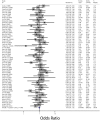Apolipoprotein E gene polymorphism and risk for coronary heart disease in the Chinese population: a meta-analysis of 61 studies including 6634 cases and 6393 controls
- PMID: 24755673
- PMCID: PMC3995769
- DOI: 10.1371/journal.pone.0095463
Apolipoprotein E gene polymorphism and risk for coronary heart disease in the Chinese population: a meta-analysis of 61 studies including 6634 cases and 6393 controls
Abstract
Background: Numerous studies have evaluated the association between the apolipoprotein E (apoE) gene polymorphisms in coronary heart disease (CHD). However, the results remain uncertain. We carried out a meta-analysis to derive a more comprehensive estimation of the association in Chinese population.
Methods: Case-control studies in Chinese and English publications were identified by searching databases of PubMed, EMBASE, Web of Science, CNKI, CBM, Wanfang, VIP and hand searching of relevant journals and the reference lists of retrieved articles. Odds ratio (OR) and 95% confidence interval (CI) were applied to assess the strength of the associations. Subgroup analysis and sensitivity analysis were performed to explore the between-study heterogeneity.
Results: We finally identified 61 relevant studies which comprised 6634 case-patients and 6393 controls. The pooled OR for ε4 carriers was 96% higher than the ε3/3 genotype for CHD (OR, 1.96; 95% CI, 1.70 to 2.24; P<0.001). However, there was no evidence of statistically significant association between ε2 carriers and risk of CHD (OR, 1.02; 95% CI, 0.91 to 1.13; P = 0.729). In the subgroup analysis, different endpoints may partially account for the heterogeneity. No publication bias was found.
Conclusions: Our meta-analysis suggests that the apoE ε4 allele may be a risk factor for CHD in the Chinese population, however, ε2 allele has no significant association.
Conflict of interest statement
Figures




References
-
- Kullo IJ, Ding K (2007) Mechanisms of disease: The genetic basis of coronary heart disease. Nat Clin Pract Cardiovasc Med 4: 558–569. - PubMed
-
- Mi X, Eskridge KM, George V, Wang D (2011) Structural equation modeling of gene-environment interactions in coronary heart disease. Ann Hum Genet 75: 255–265. - PubMed
-
- Talmud PJ (2007) Gene-environment interaction and its impact on coronary heart disease risk. Nutr Metab Cardiovasc Dis 17: 148–152. - PubMed
Publication types
MeSH terms
Substances
LinkOut - more resources
Full Text Sources
Other Literature Sources
Miscellaneous

